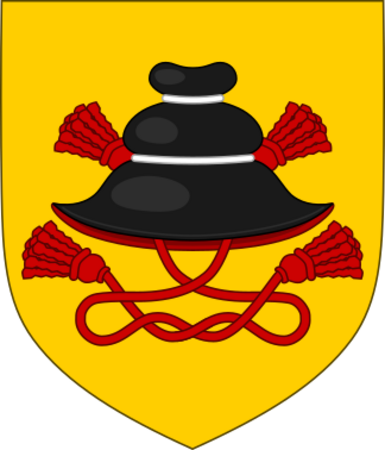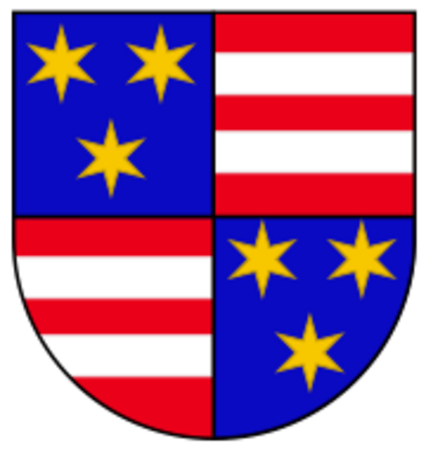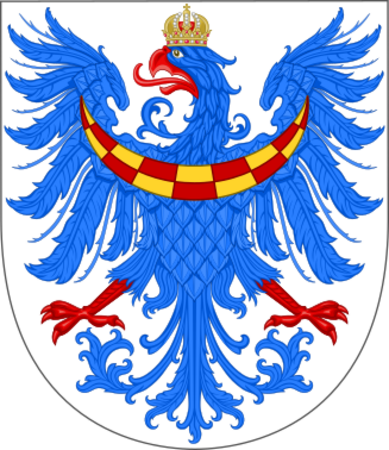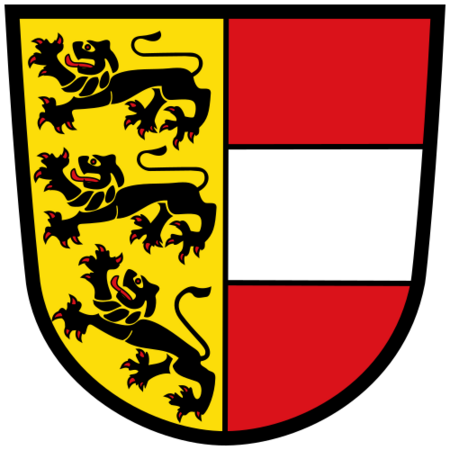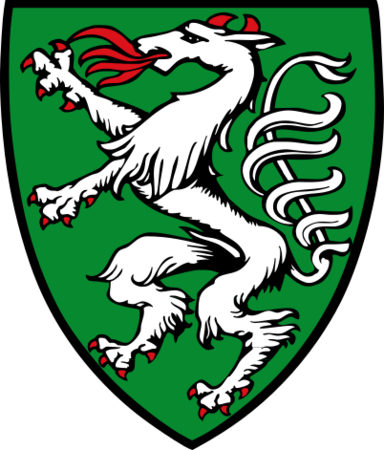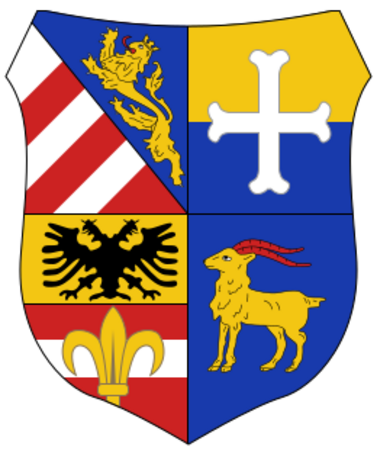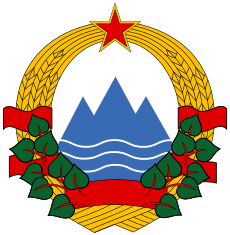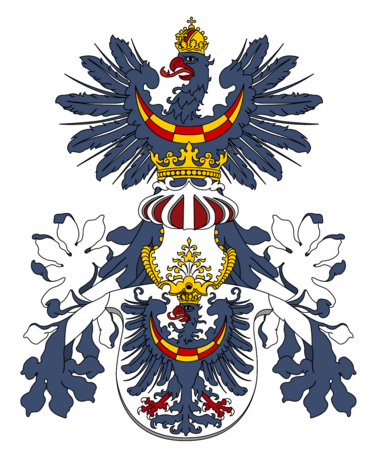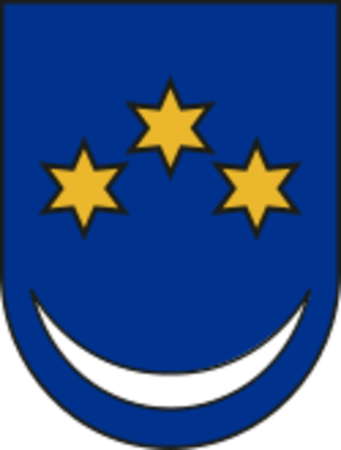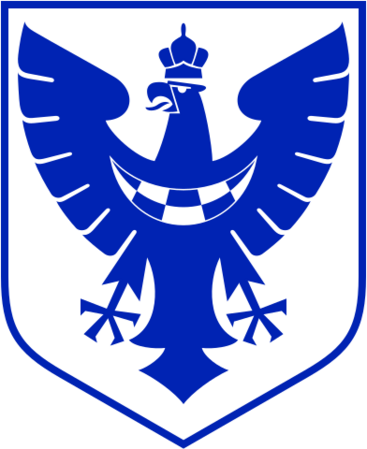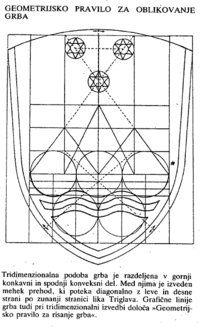Coat of arms of Slovenia facts for kids
Quick facts for kids Coat of arms of Slovenia |
|
|---|---|
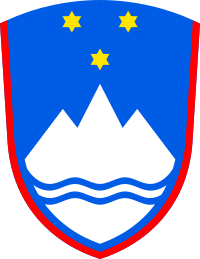 |
|
| Armiger | Republic of Slovenia |
| Adopted | 1991 |
The Slovene coat of arms is the official symbol of Slovenia. It looks like a blue shield with a red border. On the shield, you'll see a white picture of Mount Triglav, which is Slovenia's highest mountain. Below the mountain, two wavy lines show the country's sea and rivers. Above Mount Triglav, there are three golden stars with six points. These stars stand for the Counts of Celje, who were important rulers in Slovenia's history. Marko Pogačnik designed this coat of arms in 1991. It became official on June 24, 1991.
Contents
History of Slovenia's Coat of Arms
Early Symbols Under Habsburg Rule
For a long time, the land that is now Slovenia was part of the Austrian Empire. During this period, there wasn't one single coat of arms for all of Slovenia. Instead, each historical region had its own symbol.
Some of these regions included:
- The Duchy of Carniola
- The southern part of the Duchy of Carinthia
- The lower part of the Duchy of Styria
- The County of Gorizia and Gradisca
Slovenia's First National Symbol
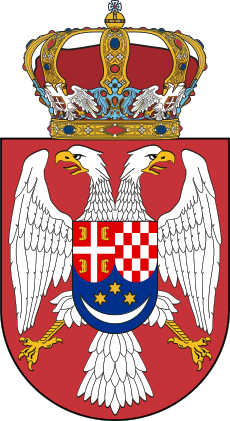
After World War I, Slovenia joined with other South Slav nations to form the Kingdom of Yugoslavia. This was the first time Slovenia had a symbol representing its people as a whole. It was part of the larger Yugoslav coat of arms.
This symbol was based on the Serbian coat of arms. It featured a Serbian shield on the left and a Croatian shield on the right. Below them, a blue shield represented the Slovenes. You can see this old royal Yugoslav coat of arms on a 1926 10-Yugoslav dinar banknote.
The Socialist Era Emblem
After World War II, Slovenia became the Socialist Republic of Slovenia. It was one of six republics in the Socialist Federal Republic of Yugoslavia. The new emblem was designed by Branko Simčič. It looked similar to symbols used in other communist countries.
This emblem also included Mount Triglav and wavy lines for the sea. It was surrounded by wheat stalks and linden leaves. A red star was placed at the top.
The Modern Slovenian Coat of Arms
In May 1991, Slovenia looked for a new design for its coat of arms. Marko Pogačnik won the competition. He based his design on Slovenia's natural beauty and important cultural works. He was inspired by the poet France Prešeren and the architect Jože Plečnik.
Pogačnik's design shows nature as described in Prešeren's poem The Baptism on the Savica. It also follows a design carved by Plečnik in 1934. This carving is on a column in front of the parish church in Bled.
The new coat of arms became official on June 24, 1991. This happened with a change to the Slovenian Constitution.
Other Historical Symbols
-
A symbol for Slovenia and the Illyrian movement on the Coat of arms of Yugoslavia (1918–1941)
What the Symbols Mean
The designer, Marko Pogačnik, sees the coat of arms as a special symbol. He believes it creates a strong energy field that protects Slovenia. It also helps bring out the country's hidden strengths.
Here's what the different parts mean:
- Mount Triglav represents the male principle.
- The two white wavy lines below Triglav stand for the Triglav Lakes Valley. They also represent Slovenia's sea and rivers, symbolizing the female principle.
- The three golden, six-pointed stars above Triglav form a triangle. They stand for democracy. These stars come from the old coat of arms of the Counts of Celje.
Rules for Using the Coat of Arms
The coat of arms of Slovenia is an official work. This means it is not protected by copyright laws. However, there are rules about how it can be used. These rules are set out in a special law from 1994. This law explains how to use the coat of arms, the flag, and the national anthem of Slovenia.
What Some People Think
Some experts have shared their thoughts on the coat of arms. For example, a heraldry expert named Aleksander Hribovšek has pointed out a few things. He says the coat of arms doesn't have an official description in heraldry terms, called a "blazon." He also thinks the shape of the shield isn't a standard heraldic shape. He has also mentioned that Mount Triglav and the sea are not shown in a perfectly traditional way.
See also
 In Spanish: Escudo de Eslovenia para niños
In Spanish: Escudo de Eslovenia para niños


